![]() 1st Battalion 22nd Infantry
1st Battalion 22nd Infantry ![]()
Soldiers' Story
Iraq 2003-2004
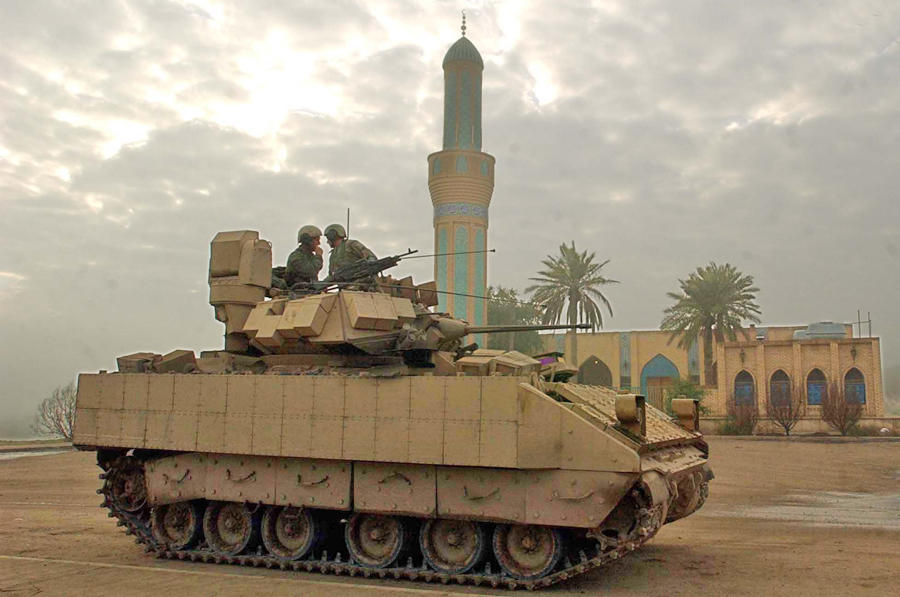
A Bradley Fighting Vehicle from 1-22 Infantry patrols near a mosque in Tikrit
AP Photo/Gregorio Borgia
SOLDIERS' STORY
Matthew B. Stannard, Chronicle Staff Writer
Published 4:00 am, Sunday, February 1, 2004
2004-02-01 04:00:00 PDT Tikrit, Iraq -- An Iraqi man shouted out
after the squad of American soldiers, two garbled English words
as they echoed through a narrow concrete alleyway.
Pfc. Matthew Bledsoe paused and swiveled his head to catch the
words, the burlap strips dangling from his helmet swaying with
the motion.
"Was that a 'f -- you?' " he asked. "Or a 'thank
you?' "
It was a familiar moment in Iraq, a place where, as an American
soldier, you often can't tell the difference between people
who want to kiss you and people who want to kill you.
There are few places in Iraq where that distinction is more
difficult to make -- or more essential to make quickly --
than in Tikrit, Saddam Hussein's adopted hometown and his onetime
seat of power.
The soldiers who patrol Tikrit -- the 1st Battalion, 22nd
Infantry of the U.S. Army's 4th Infantry Division, known
familiarly
as the 1-22 -- have been in Iraq for more than nine months and
they are tired. Bone tired.
But there are smiles on their faces these days as they catch
glimpses of new troops, their shoulders bearing the big red 1
of the 1st Infantry Division, whose soldiers are getting ready to
take over in Tikrit.
After months of rumors, disappointments and dashed hopes, the 4th
Infantry Division is preparing, within the next two months or so,
to go home. It will be the last of the divisions that fought the
war in Iraq to leave.
It wasn't the kind of war they came prepared to fight. The
battalion, more than 600 strong, entered Iraq from Kuwait late in
the conflict.
They arrived from Fort Hood, Texas, trained and rested, with tons
of the most lethal and sophisticated military hardware ever
produced.
They were ready for serious combat.
Instead, they spent their first days driving north, taking
pictures of shattered Iraqi tanks and of children trying to steal
gear
strapped to the outside of the humvees.
Sgt. Mike Evans of Cobra Company knew the calm wouldn't last.
"I told them all before we left, 'Somebody in this formation
ain't coming back,' " said Evans, 35, who made it to the
Euphrates River
as a sniper in the 1991 Persian Gulf War and may be the most
respected soldier in the 1-22.
"About six days after we crossed the border, we had our
first casualty. That opened up their eyes real fast. This wasn't
a simulation --
this was real," he said. "They grew up fast."
It was a lesson relearned in Tikrit. Although Republican Guard
holdouts engaged the Americans in a series of short, sharp
battles,
resistance was minimal at first.
Lt. Col. Steve Russell, commanding officer of the 1-22, said that
at first the patrolling soldiers visited homes for dinners,
bought trinkets in the marketplace and tried to socialize with
the locals.
"June changed all of that," said the 40-year-old
officer from Del City, Okla. "That's really when the
guerrilla war started for us."
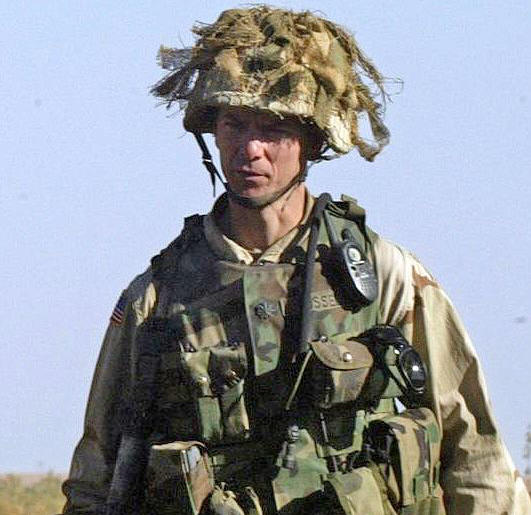
LTC Steve Russell - Commanding Officer 1-22 Infantry
The hot months -- June, July and
August -- were bad ones for the 1-22. As attacks on the streets
of Tikrit increased,
so did the temperature. At times, soldiers were on rations of
only two half-liter bottles of water a day as the
thermometer soared into the 120s.
Rumored departure dates in August -- and on Halloween,
Thanksgiving and Christmas -- came and went. Each time,
the soldiers of 1-22 thought they were going home, despite
Russell's estimate that the campaign would require a year.
Tempers flared. Fistfights erupted in the barracks.
In October, three members of the 1-22 were killed in attacks, two
in a single weekend. And after each casualty, Capt. Xuan Tran,
the 1-22 chaplain, counseled soldiers who felt like turning their
rage against the Iraqi people.
"We are human beings. And when you see your roommate killed
... you will experience some emotion," he said. "
(But) if we have that mentality, it could be very bad. It could
be a massacre."
Russell and the 1-22 responded by locking down Tikrit,
supplementing tank and humvee patrols with more foot patrols.
Al-Awja, where Saddam Hussein was born, was fenced off
completely, and residents needed to show identification
to come and go. Attacks were met by force, and soldiers
aggressively searched for insurgents.
"In the early days, we'd get a tip and search a whole
block," Lt. Michael Isbell recalled.
"I remember one day we searched 132 houses straight."
Tikritis chafed under the tight leash, and the tough tactics drew
some criticism from observers in the United States.
Russell makes no apologies: Different populations require
different techniques, he says, and the techniques he chose
worked.
"People have the notion that the American soldier is somehow
untrained for this mission," he said.
"But our history belies that. We both know how to fight and
how to handle civilians."
Attacks peaked in July, when there were more than 60, then
dropped sharply in August to about 30 as the Americans' strategy
began to pay off. Then the insurgents switched tactics, turning
to hit-and-run assaults and roadside bombs, and attacks
climbed to about 55 in November. But that number, too, has been
falling steadily, Russell said, to about a dozen in January.
Tikrit began to come to life with new shops and people strolling
in the streets. The city government began to function,
with a new mayor elected by a governing council of sheikhs. A
week ago, police began to hand out parking tickets --
and people are paying them.
"Eventually, you learn to respect the city. But the city
also respects us, " said Capt. Brad Boyd, 34, Cobra's
commander
and a San Jose native who still limps from the shrapnel wounds he
sustained from a roadside bomb in December.
"They understand we are extremely lethal if we need to be,
but they also know we'd rather hand out candy."
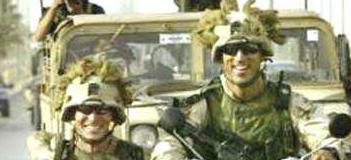
Left: Captain Brad Boyd,
right: 1SGT Michael Evans both of Cobra Company 1-22 IN
Both are mentioned in this story.
REUTERS/Damir Sagoljhttp://www.reuters.com/
These days, Tikrit has calmed
down so much that there is time for the soldiers to be bored, to
sit in the barracks
playing video games and killing flies with pocketknives. But it
is an uneasy calm.
A few of the soldiers are torn between wanting to see action
again before they head home and wanting things to stay quiet
enough
to guarantee that they make it home alive.
The 1-22 is divided into camps across the region they patrol.
Cobra Company is bivouacked in Hussein's "Birthday
Palace,"
from which the former president would review parades in his
honor, firing a rifle in the air from his balcony.
Boyd's bed is in Hussein's old bedroom.
Gator Company is camped in Al-Awja, in a party palace next door
to Saddam Mosque,
where they cook Spam in the banquet-quality kitchen.
The specialty platoons -- medics, mortar-firers, headquarters and
scouts -- are in the House of Saladin, a palace named
for the Tikrit-born general who defeated the Western armies in
Jerusalem in the late 12th century.
The Tikrit compound offers good food -- king crab legs made the
menu recently -- in a cavernous mess hall where colonels
and privates eat side by side. There are hot showers, laundry
facilities and the "Ironhorse Resort," a palace
boasting
a swimming pool, Internet cafe and a bazaar where local Iraqis
sell "Saddam lighters" for $5 and pirated DVDs for $3.
About 70 percent of the time is now down time, the soldiers say.
But the remaining 30 percent can kill you.
One recent night, the movie -- "A Fish Called Wanda" --
was just getting rolling. Wanda had double-crossed her partner in
crime,
and was preparing to seduce Archie into telling her which
safe-deposit box matched the key she had found in Ken's fish
tank.
Then the first mortar hit.
"Goddammit!" snapped Sgt. Mark Dornbusch, 24, of
Austin, Texas, as the first thunderous explosion echoed outside.
"Let's go!"
The men of Gator Company jumped off the ornate couches and chairs
and sprinted outside, strapping on body armor
and helmets as a second round burst just outside their walled
compound.
For the next hour, they stopped and searched Iraqi cars
throughout the city of Al-Awja, using pidgin Arabic to try to
find
witnesses to the attack. No one would admit even hearing the
thunderous explosion.
Eventually, Gator returned to its compound to track the mortars
using the crater patterns outside their walls -- and to wait for
the next attack.
It is a threat that never ends and can rarely be anticipated.
Patrols regularly uncover caches of hundreds of mortar rounds,
rocket-propelled grenades (RPGs) and AK-47s.
"A couple of months ago, my dad asked me, 'Are you scared
when you go outside the gate?' " Evans said.
"I said, 'No, I'm not scared. I'm terrified.' "
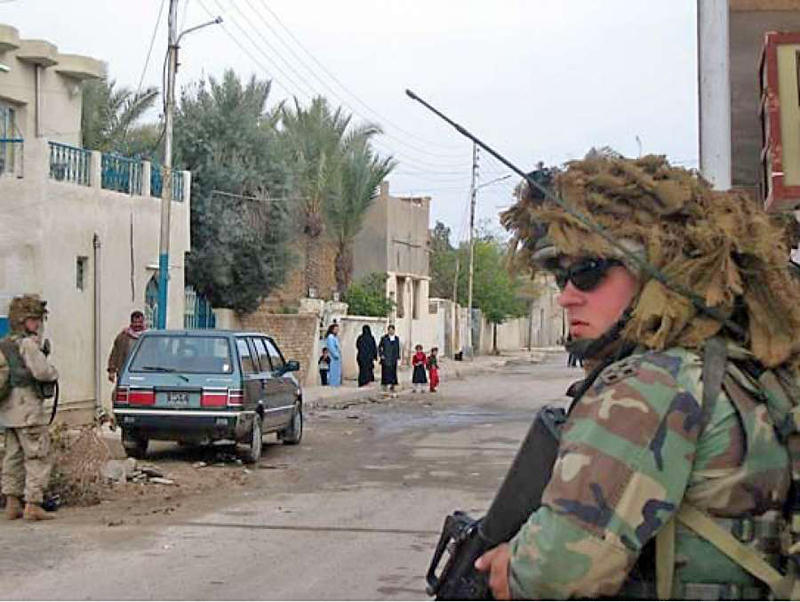
SPC Matthew Bledsoe of 1-22 IN on patrol in Tikrit
Photo by Matthew Stannard/The Chronicle
Leaving the relative security of
the palaces for any reason requires gearing up with an armored
vest, Kevlar helmet and loaded weapon --
about 50 pounds of equipment, just to walk the 100 yards to the
shower.
And it's not just infantry troops who suffer. Engineers, support
troops, even medics have died or been injured working with the
1-22.
One of the six soldiers killed in combat while serving with the
1-22 was Pfc. Analaura Esparza Gutierrez, a 21-year-old
supply specialist from Houston.
"I always thought cooks and females were behind the
lines," said Spc. Felissa Maddox, 22, a cook who survived a
roadside
bomb attack on her convoy in December. "The infantry guys do
more patrols than we do ... (but we're) the same."
On the outer wall of the building where she lives, an unexploded
rocket- propelled grenade can still be seen protruding from the
marble.
"Every time you walk out of the gate, you take a risk,"
said Spc. John Ott, who fuels military vehicles.
"We wear 'American soldier' on our chest, just like they
do."
The constant tension has led some soldiers close to a breakdown,
Capt. Tran said. The rest maintain a state of hyper-vigilance
for anybody who looks like one of their attackers.
That means almost anybody in Tikrit.
The Cobra humvee roared up to the House of Saladin, and soldiers
hustled an injured Iraqi man inside to the medics.
Outside, the wounded man's friend lay cuffed in the back of the
vehicle.
Soldiers tried to explain the situation to the handcuffed man: An
American soldier had been shot in the hand by a sniper
and reported a white truck leaving the scene. When a Cobra patrol
spotted a white truck moments later, Evans stepped
in front of the vehicle, ordering it to stop. The driver failed
to stop, the soldiers said, and Evans fired warning shots
into its engine and, finally, through the door, hitting the
driver in the buttock.
The explanation, delivered in a mix of English and pidgin Arabic,
did not seem to get through. The cuffed man looked from
American soldier to American soldier, saying, "No,
Saddam" and "Yes, Bush," before weeping in panic
and crying out to Allah.
No weapons were found in the truck. It was the kind of encounter
that critics of the war point to as examples of American soldiers
responding too quickly and too harshly to threats of violence.
But on the streets of Tikrit, the soldiers say, they have to
depend on instinct and "situational awareness" and
can't lose time
worrying about their critics in Iraq or at home.
"I worry about me and my men," Cobra Spc. Jacob Lynn
said.
Sgt. John Garza tucked a fresh plug of Copenhagen behind his lip
and spat out the back of his Bradley, which was positioned
to observe the convoys beginning to haul the battalion's gear
from Tikrit to Kuwait in preparation for their long-awaited
withdrawal.
"Where (insurgents) have the advantage is we're looking for
the bad guys in a crowd of civilians," said Garza, 23.
"They look for the guys with the burlap on their
heads."
Some say the burlap strips, intended as camouflage, make their
helmets more intimidating; some say they look like
Sideshow Bob from "The Simpsons" television show. In
any case, the look, which they often use on patrol,
sets the 1-22 apart, which can be a good thing or a bad thing.
On one hand, they feel a certain respect from the Tikritis, who
see the helmets and know they are the soldiers most directly
involved
in securing the streets. On the other hand, they fear it makes
them targets. Russell himself has been attacked more than a dozen
times.
One roadside bomb exploded prematurely, killing two bombers about
half a block from his convoy. His soldiers are certain
the attackers knew exactly who they were targeting.
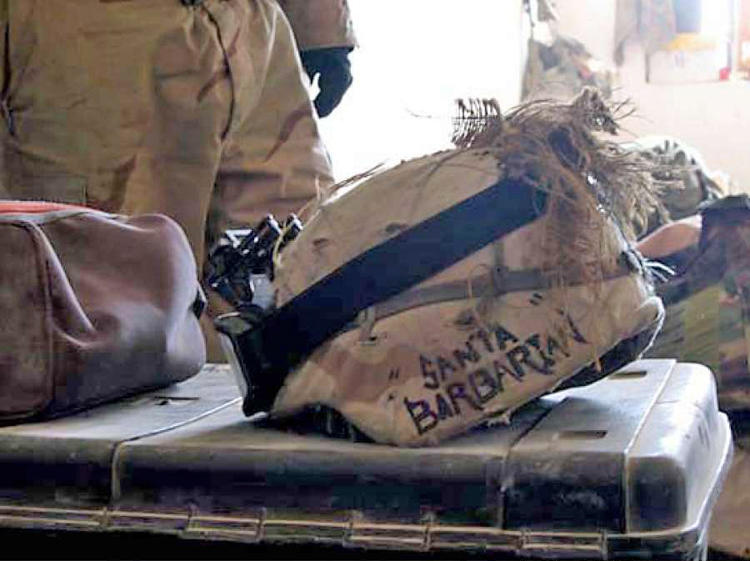
Helmet belonging to SPC Erlane Fay of 1-22 IN with strips of burlap fastened to it
Photo by Matthew Stannard/The Chronicle
Still, members of the 1-22
continue their patrols, hoping their visibility will either
intimidate attackers into staying home --
or draw them into the open by offering a target.
"It's kind of like hunting with live bait," said Staff
Sgt. Scott Feucht. "We're the live bait."
Feucht spoke in the middle of a patrol through Tikrit's streets,
which were filled with Iraqis going about their daily business.
"This guy over here might be Mr. Nice Guy who wants to
invite you in the house for some tea, while the guy across the
street
might want to shoot you in the back with a friggin' RPG,"
Lt. Jason Lojka said.
Sometimes, the same person plays both roles.
"You might go by a house and the guy is smiling and waving,
'Hey, mister, mister, I love Americans,' " he said.
"And then you go around the house ... and find him flipping
off the last guy in the column."
The soldiers' experiences have led them to have decidedly mixed
emotions about the people they came to liberate.
A number of soldiers said they hold the Iraqi insurgents in
something close to contempt, especially since they abandoned
traditional fighting for guerrilla warfare.
"They'll shoot you in the back or use IED's (improvised
explosive devices, or homemade bombs),"
said Spc. Rodrigo Vargas, 23, of Houston. "They're not going
to fight you head on."
Some soldiers say the citizens of Tikrit became accustomed to the
favors granted by Hussein and are ungrateful for their
new freedoms. Others say the Iraqis are lazy, pointing to the
trash lining Tikrit's streets and human excrement in the gutters.
They bristle at the failure of some Iraqis to cooperate, their
insistence that they know nothing of any insurgents, even
in areas from which attacks have emanated.
"They'll tell you, 'No fedayeen in Tikrit,' " Garza
said. "If Jimmy Hoffa moved to my street, I would know who
the hell he was."
Some soldiers privately admit that in the worst times, when
soldiers die at Iraqi hands, they feel like taking a .50-caliber
machine gun into downtown Tikrit and mowing down every Iraqi they
see. In those times, sergeants and officers try hard
to temper their soldiers' anger without dulling their edge.
"You don't want them going crazy out there, but you don't
want them hesitating," said Cobra Staff Sgt. John Minzer.
"You try to train people: 'If you're going to shoot someone,
you're going to have to live with that your entire life.' "
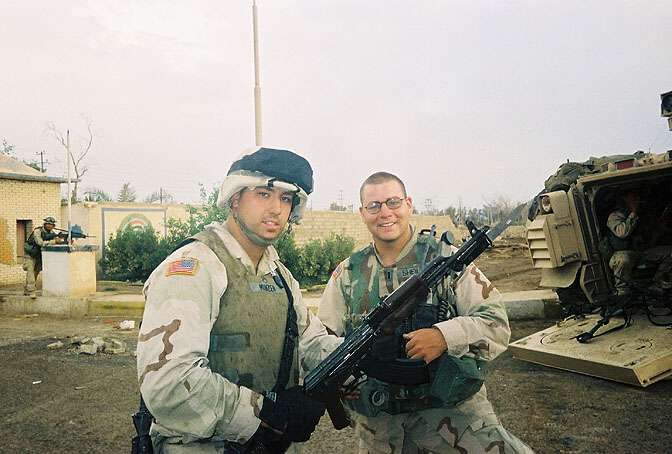
SSG John Minzer of Cobra Company 1-22 IN on left with captured Iraqi AK-47
Photo courtesy of John Minzer
But the soldiers' attitudes
toward the Iraqis are changeable.
"If there's people that have gotten killed or shot, your
tolerance level for Iraqis goes way down," Sgt. Andrew
Antolik, 23, said.
"If it's been a couple weeks of quiet, you'll go out and be
like, 'Hey, what's up. Salaam aleikum. Shukran.'
(Peace be with you. Thank you.)"
Some soldiers say they have gotten to know some of the Tikritis,
and they describe friendly encounters in the middle
of a patrol when they sip tea and talk about their families and
religions.
"There's a lot of good people in this city that mean well.
I've got a lot of Iraqi friends," Evans said. "About 20
percent
of the people are just idiots -- those are the ones you've got to
watch for."
Today, with attacks on the decline, few soldiers seem to display
a hatred for the Iraqis. Many view the Iraqis with pity,
as people broken by decades of war and despotism whose
assumptions about how the Americans would treat them
were shaped by how they were treated by Hussein.
"They had an awful regime under Saddam," Spc. Stewart
Tignor said. "They don't understand democracy,
they don't understand us. So really they're just trading one
regime for another."
For many soldiers, the face of the Iraqi people is often a
child's face. The children chase after patrolling soldiers,
accept their candy and trade pidgin English for pidgin Arabic,
slap hands and have belching contests
with the patrolling soldiers as their parents watch warily from a
distance.
They see the children as barometers: If children wave at a
soldier while their parents are watching, they figure
the parents probably like the Americans, too, even if they don't
show it. If a child scowls or throws a rock,
it suggests the parents are less fond of the Americans -- and
their house might be due for a quick search.
But for other soldiers, the appeal of the children is simpler
than that.
"When you see the kids, and you realize (Hussein) had these
big palaces and the people down the street didn't have water,
you realize what this place is all about," Boyd said.
"The criminals were running the place."
In the nine months since they arrived in Iraq, the members of the
1-22 have recovered huge caches of weapons;
they've done battle with insurgents, and they've even uncovered
information during raids that helped lead
to the capture of Saddam Hussein. In the process, they've lost
six soldiers.
Was it worth it? Each soldier has his own answer.
"Did I honestly think doing this and coming over here was
going to stop terrorism? No. That's the dumbest thing I ever
heard,"
Isbell said. "There are no weapons of mass destruction that
we've seen. These people didn't even have an air force. ...
I didn't even see an army."
Other soldiers see Iraq as a containment zone for terrorists.
"Bullets flying all over the place; I'd rather that happen
over here than at my home," Vargas said.
"I don't want my wife dropping my little girl off at school
getting hit with crossfire."
Their estimates of how long it will take for Iraq to be at peace
range from a year to 20 to never.
"We can spend millions of dollars in fixing up schools,
fixing up roads, they're still going to hate us," Sgt.
Curtis Keltner said.
"We're Westerners. They're never going to accept our
culture."
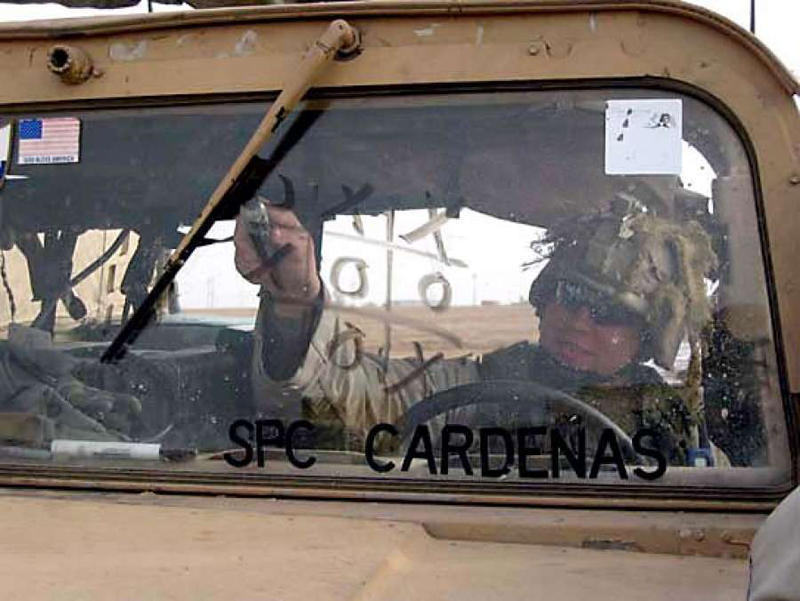
SPC Sergio Cardenas of 1-22 IN kills time in his humvee in Iraq
Lifers say they expect to rotate
back to Iraq some day; some newer recruits say they will not
re-enlist to avoid that fate.
But most say they have accomplished their mission -- a mission
they see as simpler and more straightforward
than the geopolitical consequences often debated in the United
States.
"When you join the military ... there's a deep-seated notion
of honor, doing the right thing, nobility," Isbell said.
"If I go (to Iraq) and give them some of the luxuries I've
been living with, that's a good thing."
Rather than claiming to have saved the world from terror or
chemical weapons, the soldiers say they see in the streets
of Tikrit a new life, new businesses, new possibilities, even if
the people walking those streets still complain bitterly
that their lives were better under Hussein.
"If you understand the history of this area, I don't think
they'd know peace if it bit them in the ass," Vargas said.
"You can get rid of a government. You can get rid of the
dictator. But you can't get rid of the idea. Hopefully we can,
or at least show them a better way. ... If we show them a better
way, maybe they'll choose it."
For many, the goal is worth the sacrifice they've made, said
Staff Sgt. Tony Bach, a medic for Cobra Company.
"I question, why do I have to put a 19-year-old kid in a
body bag?" he said. "But then I see a little kid.
And that's what we're here for -- to put an end to
oppression."
As the sun set over the Tigris River behind the House of Saladin,
Sgt. Ricky Hines threw another letter from home
onto the garbage fire. He has five chests filled with
correspondence, he said. They sustained him during the war;
now he is done hauling them around. "It's time to go
home."
The soldiers will go home changed. Many had never fired a shot in
combat before they came to Iraq.
Now, they have killed and seen their friends killed.
Some have already seen the changes in themselves when they went
home on leave. Some woke up dreaming of combat
or pulled their car over to check a box by the side of the road
for explosives. Others felt naked as they walked unarmed
through crowds of strangers in the airport or the mall.
They've heard about "shell shock" and post-traumatic
stress, and they talk about a handful of men of the 3rd Infantry
Division,
who went home after the war and killed their wives or themselves.
Suicide rates during this conflict have already been abnormally
high,
according to the Army. Knowing that, some soldiers worry what
will happen to their buddies when they get home.
"This battalion will have more deaths in the first 30 days
after we get back than we did in the whole deployment,"
speculated Spc. Darryl Saylor, 25, of Baltimore.
But Russell and Evans, combat veterans both, said they don't
worry about their soldiers. True, some have experienced
the horrors of war firsthand, but they have a powerful resource
to help them cope -- friendships tested in battle
that will see them through the difficult transition ahead.
"The company has come and formed a band of brothers,"
Evans said. "Joes are gonna be Joes when they get
back."
Spc. Percell Philips will take home a scar by his right eye and
the bullet that lodged in his helmet after grazing his skull.
He considers himself the luckiest man in the 4th Infantry
Division.
He shot his attacker dead. Later, he saw the man's corpse in a
hospital and considered taking a photo
but decided he didn't want to take that memory home with him.
"I see my little nephews when I go home. They ask me how
many people I killed," he said. "I tell them, 'None.'
"
|
SPC Benito Garcia of 1-22
IN
Photo by Matthew Stannard/The Chronicle |
Dangerous mission
The 1st Battalion, 22nd Infantry
is part of the 4th Infantry Division, considered one of the
Army's most advanced divisions
for its sophisticated computer network linking its M1 Abrams
tanks, Bradley Fighting Vehicles and Apache helicopters.
Still, it nearly missed the major combat at the beginning of the
war.
The military had planned to use the powerful mechanized division
to invade Iraq through Turkey, but the Turkish parliament
blocked that plan, refusing to let the U.S. military use the
nation as a staging ground. After months of delays, the division
moved to Kuwait in late March and rumbled across the border into
Iraq on April 13, four days after the fall of Baghdad.
It sped north to the capital in 40 hours, secured al-Taji
airfield north of Baghdad and on April 19 rolled into Tikrit,
a stronghold of Saddam Hussein loyalists, where it has
encountered some of the stiffest resistance of the conflict.
In addition to attacks that killed members of the 1-22, other
notable events:
-- July 29 -- Soldiers detain more than 175 suspected Hussein
loyalists, including a top bodyguard, in a predawn raid near
Tikrit.
-- Aug. 2 -- At least two U.S. soldiers are injured in remote-
controlled explosions in Tikrit after elders of Saddam Hussein's
tribe
bury the ousted dictator's sons, Odai and Qusai, in Al-Awja,
where Hussein was born.
-- Aug. 12 -- American soldiers round up 14 members of a family
that supported Hussein, including a Republican Guard officer
and one of the dictator's bodyguards.
-- Sept. 27 -- Troops uncover a huge weapons cache in Al-Awja,
including 23 Russian-made surface-to-air missiles, 1,000 pounds
of plastic explosives, four rocket-propelled-grenade launchers
and 115 rockets, 1,300 blasting caps and 423 hand grenades.
-- Oct. 30 -- To quell attacks, soldiers stretch concertina wire
around the village of Al-Awja, requiring residents to show ID to
enter or leave.
-- Nov. 7 -- A Black Hawk helicopter crashes near Tikrit,
apparently shot down by a rocket-propelled grenade,
killing all six U.S. soldiers aboard -- four from the 101st
Airborne Division and two from Army headquarters.
-- Jan. 7 -- Soldiers arrest 12 Iraqis wanted for attacks on
forces in Tikrit, including the Oct. 1 killing of Analaura
Esparza Gutierrez.
Source: Chronicle research
Fallen soldiers of the 1-22
During the United States' war in
Iraq, six soldiers serving with the 1st Battalion, 22nd Infantry
of the Army's 4th Infantry Division
have been killed in combat and more than 50 have been injured.
Those who were killed are:
-- 1st Lt. Osbaldo Orozco, 26, of Earlimart, (Tulare County),
died April 24 when his Bradley Fighting Vehicle flipped over
as it maneuvered to return fire during an attack in Tikrit.
-- Pfc. Jesse M. Halling, 19, of Indianapolis, a member of the
401st Military Police Company who was attached to the 1-22,
was killed by a rocket- propelled grenade June 7 while defending
the Civilian Military Operations Center in Tikrit.
-- Pfc. Analaura Esparza Gutierrez, 21, of Houston, a member of
the 4th Forward Support Battalion, attached to the 1-22,
was killed Oct. 1 when a roadside bomb struck her humvee near
Tikrit.
-- Spc. James E. Powell II, 26, of Radcliff, Ky., died of
injuries he suffered Oct. 12 when the Bradley Fighting Vehicle
he was riding in struck an anti-tank mine in Baji, north of
Tikrit.
-- Donald Wheeler, 22, of Concord, Mich., was killed Oct. 13 when
his unit was fired on by a rocket-propelled grenade in Tikrit.
-- Pfc. Ervin Dervishi, 22, of Fort Worth, Texas, died Jan. 24
when a rocket-propelled grenade hit the Bradley Fighting Vehicle
in which he was traveling in Baji.
Sources: Fort Hood Public Affairs Office; Lt. Col. Steve Russell
Above article from the SFGATE website
Additional photos added by the website editor
Home | Photos | Battles & History | Current |
Rosters & Reports | Medal of Honor | Killed
in Action |
Personnel Locator | Commanders | Station
List | Campaigns |
Honors | Insignia & Memorabilia | 4-42
Artillery | Taps |
What's New | Editorial | Links |